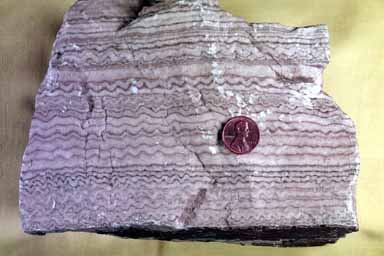|
GYPSUM #1 Alabaster gypsum Go on to: #1 | #2 | #3 | #4  Detail of this specimen
Detail of this specimen>>> Other examples
Return to: Alphabetical Listing Basic Key Carbonate Key |
||
|
Composition
CaSO4 . H2O; Hardness 1.5-2; Cleavage perfect one direction, distinct in other two (when visible); white, colorless, gray, yellow, red, brown; Luster pearly on cleavages.
|
Description
Laminated alabaster gypsum. Gypsum takes on many forms, such as alabaster, selenite, satin spar, and rose gypsum.
|
|
|
Tectonic Association
None specific. Gypsum will form in any environment in which there is high evaporation of marine waters, and an absence of abandant clastic sediment to maske it.
|
Formation & Environments
Sedimentary gypsum forms under high evaporative conditions in sedimentary rocks, both clastic and carbonate. It usually requires desert conditions in shallow marine basins, or along coastal tidal flats. Gypsum commonly forms in association with halite and dolomite in evaporation basins. Sometimes the gypsum appears simply as gypsum roses in the sediment; other times it can form beds tens of feet thick. |
|